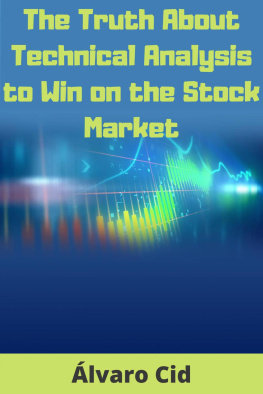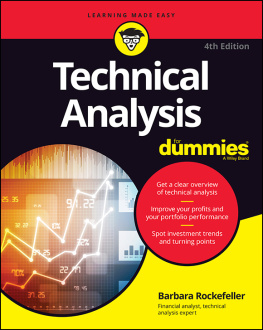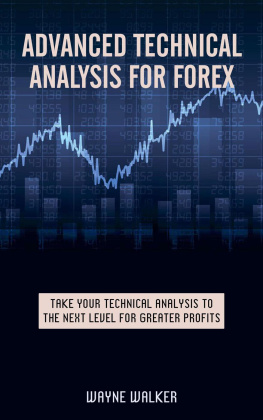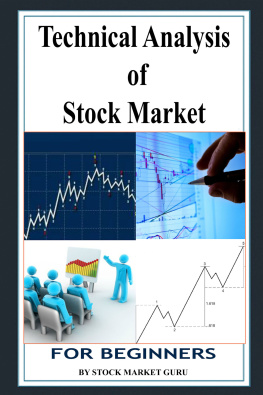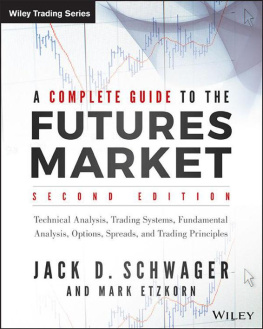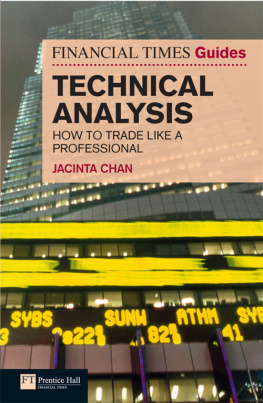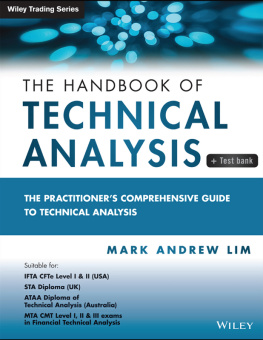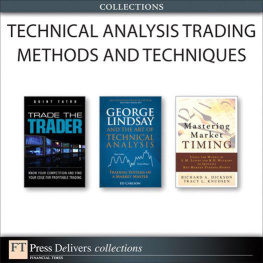TECHNICAL ANALYSIS FOR THE TRADING PROFESSIONAL
Strategies and Techniques for Todays
Turbulent Global Financial Markets
SECOND EDITION
CONSTANCE M. BROWN, CMT


Copyright 2012 by Constance M. Brown. All rights reserved. Except as permitted under the United States Copyright Act of 1976, no part of this publication may be reproduced or distributed in any form or by any means, or stored in a database or retrieval system, without the prior written permission of the publisher.
ISBN: 978-0-07-175915-1
MHID: 0-07-175915-8
The material in this eBook also appears in the print version of this title: ISBN: 978-0-07-175914-4, MHID: 0-07-175914-X.
All trademarks are trademarks of their respective owners. Rather than put a trademark symbol after every occurrence of a trademarked name, we use names in an editorial fashion only, and to the benefit of the trademark owner, with no intention of infringement of the trademark. Where such designations appear in this book, they have been printed with initial caps.
McGraw-Hill eBooks are available at special quantity discounts to use as premiums and sales promotions, or for use in corporate training programs. To contact a representative please e-mail us at bulksales@mcgraw-hill.com.
This publication is designed to provide accurate and authoritative information in regard to the subject matter covered. It is sold with the understanding that neither the author nor the publisher is engaged in rendering legal, accounting, securities trading, or other professional services. If legal advice or other expert assistance is required, the services of a competent professional person should be sought.
From a Declaration of Principles Jointly Adopted by a Committee of the American Bar Association and a Committee of Publishers and Associations
Art credits of permissions info or referral to a credits section at the back of the book.
TERMS OF USE
This is a copyrighted work and The McGraw-Hill Companies, Inc. (McGraw-Hill) and its licensors reserve all rights in and to the work. Use of this work is subject to these terms. Except as permitted under the Copyright Act of 1976 and the right to store and retrieve one copy of the work, you may not decompile, disassemble, reverse engineer, reproduce, modify, create derivative works based upon, transmit, distribute, disseminate, sell, publish or sublicense the work or any part of it without McGraw-Hills prior consent. You may use the work for your own noncommercial and personal use; any other use of the work is strictly prohibited. Your right to use the work may be terminated if you fail to comply with these terms.
THE WORK IS PROVIDED AS IS. McGRAW-HILL AND ITS LICENSORS MAKE NO GUARANTEES OR WARRANTIES AS TO THE ACCURACY, ADEQUACY OR COMPLETENESS OF OR RESULTS TO BE OBTAINED FROM USING THE WORK, INCLUDING ANY INFORMATION THAT CAN BE ACCESSED THROUGH THE WORK VIA HYPERLINK OR OTHERWISE, AND EXPRESSLY DISCLAIM ANY WARRANTY, EXPRESS OR IMPLIED, INCLUDING BUT NOT LIMITED TO IMPLIED WARRANTIES OF MERCHANTABILITY OR FITNESS FOR A PARTICULAR PURPOSE. McGraw-Hill and its licensors do not warrant or guarantee that the functions contained in the work will meet your requirements or that its operation will be uninterrupted or error free. Neither McGraw-Hill nor its licensors shall be liable to you or anyone else for any inaccuracy, error or omission, regardless of cause, in the work or for any damages resulting therefrom. McGraw-Hill has no responsibility for the content of any information accessed through the work. Under no circumstances shall McGraw-Hill and/or its licensors be liable for any indirect, incidental, special, punitive, consequential or similar damages that result from the use of or inability to use the work, even if any of them has been advised of the possibility of such damages. This limitation of liability shall apply to any claim or cause whatsoever whether such claim or cause arises in contract, tort or otherwise.
FOREWORD
Written by a brilliant trader for only those seasoned traders who are willing to work at their analysis of the markets in a disciplined way, this book contains the most advanced methodology Ive ever seen!
Connie Browns credentials come in the form of nine years on the front line as a research analyst and fund trader. She is herself a disciplined professional, who has grown to the point where she is a force to reckon with in the financial markets. At the same time, she publishes a daily bulletin on the Dow, the S&P, and Bonds. This is faxed to some of the worlds most sophisticated, large traders. Her predictions as to price objectives and trend of the market are unequaled anywhere in the industry.
There are 14 separate chapters in this book, each a separate subject. Six of these subjects have been written on before, and these chapters serve as improvements on old indicators. There are, also, 15 major breakthroughs in technical analysis! Seven of these breakthroughs are newnever-before-revealed material! Eight more dissect, change, and improve old concepts.
In her discussion of Stochastics and of RSI as oscillators, she introduces the concept that oscillators do not necessarily fluctuate between 0 and 100 and that all signals do not fall within the traditional default overbought and oversold bands. The oscillator may actually travel within a larger or a narrower range that can be pinpointed with precision. To correct what the writer perceives as a flaw in commercial software packages, she suggests the use of an upper resistance band and a lower support band within this range to help identify signals that might otherwise have been missed. She also introduces the concept that this effective signaling band may travel up and down within the range, and that it may expand or contract. She suggests that the trader should adjust this effective signaling range to compensate for the idiosyncrasies of strongly trending bull and bear markets, and even suggests some better parameters! This alone would change the way we look at oscillatorsand, consequently, our entry timing.
But this inventive young trader does not stop there. She goes on to discuss the application of moving averages over oscillators, third-generation indicators created by applying oscillators on oscillators, and filtering indicators with variants of different lengths. She introduces the Composite Index she created to accompany RSI.
In a theme she returns to frequently, she kids the Stochastics Default Clubboth the uneducated public that accepts the default values in software and tries to use them to trade without a clue as to why, and the educated but lazy trader who knows better but does it anyway. She remedies this deficit by giving a great deal of attention to procedures for determining and inputting the proper data to construct responsive, customized indicators. She makes a passionate case for keeping a flexible state of mind.
To the subject of cycles, Connie introduces the concept of growth and decay, which leads to asymmetrical cycles, and the application of a weighted factor to them, versus Fibonacci cycles. She explains the use of charts with differing time cycles to perfect cycle timing.
Approaching the subject of market price objectives, this writer naturally turns to the Elliott wave, her starting point in the industry. For some, the Elliott wave is frustrating in the extreme because the wave count appears to change when a larger cycle begins. Understanding their frustration, Connie agrees that some people are wave-deaf; just as a tone-deaf person cannot hear the music, they cannot perceive the beauty of the composition because they are caught up in counting the beats and analyzing the notations. She stresses that it is necessary to understand the structure, but more important to keep a sense of proportionality to the analysis.


